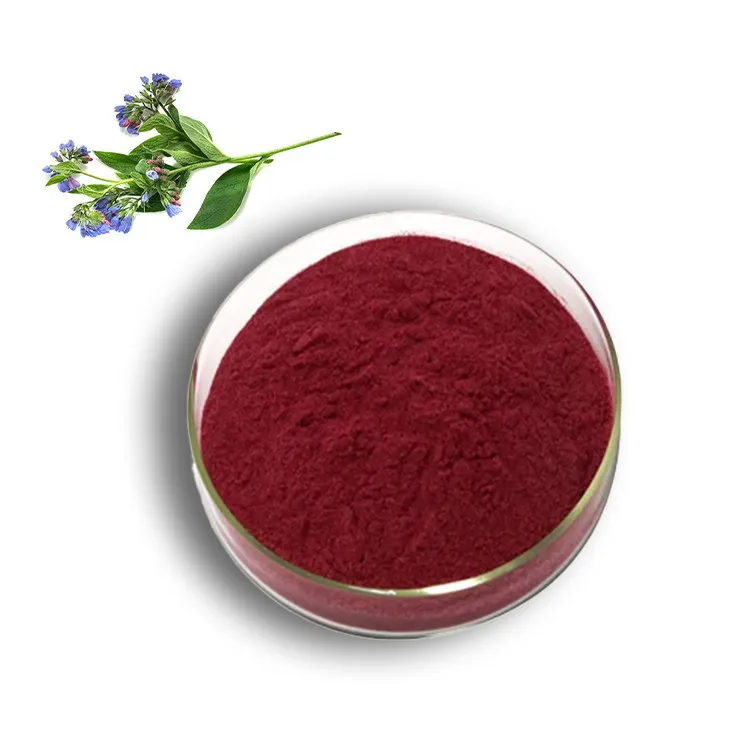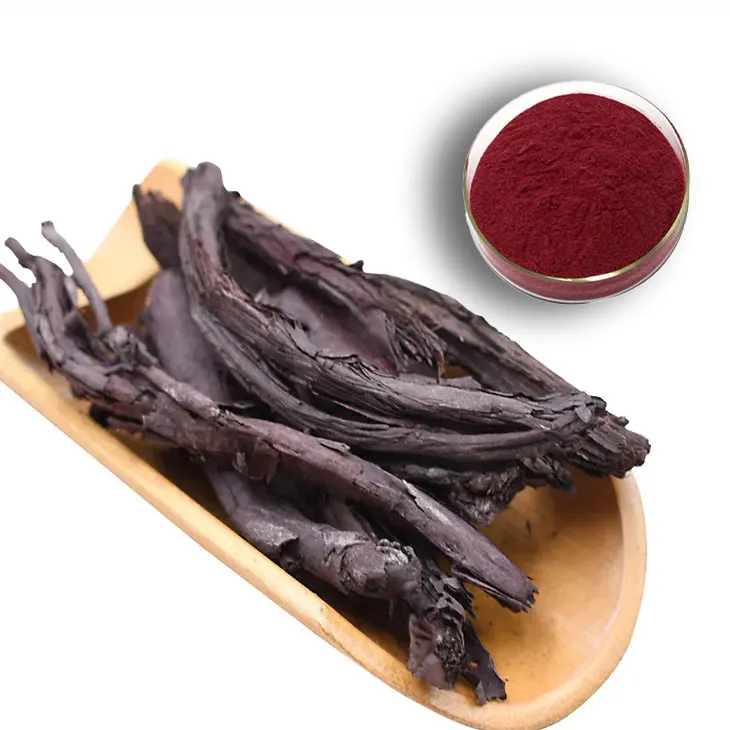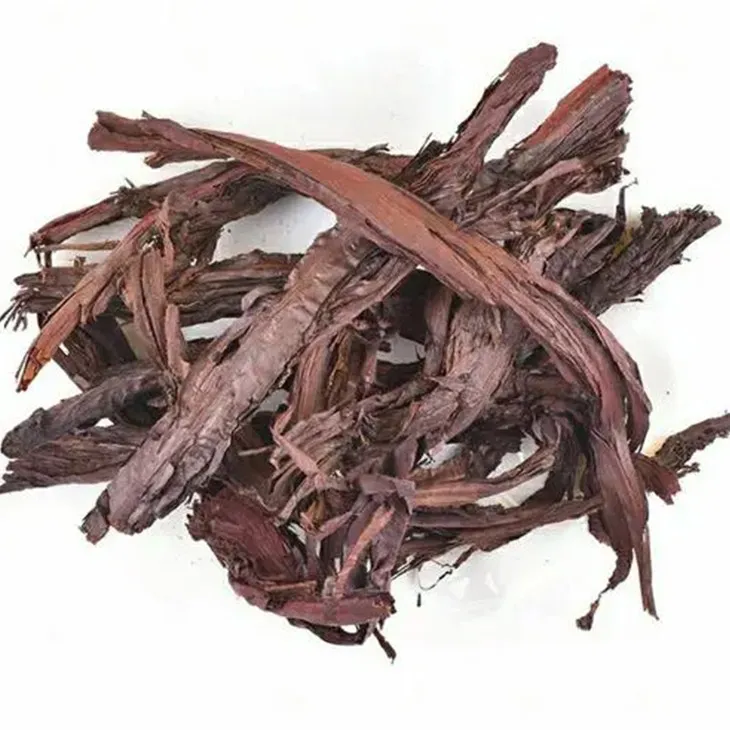- 0086-571-85302990
- sales@greenskybio.com
The process of extracting high - purity shikonin derivatives from shikonin.
2024-11-28

1. Introduction
Shikonin, a remarkable natural product, has drawn significant attention in both scientific research and industrial applications. It is a compound with diverse potential uses, ranging from medicine to being a natural dye. The extraction of high - purity Shikonin derivatives from Shikonin is a complex yet crucial process. This article will explore the detailed steps involved in this extraction process, from the initial source acquisition to the final purification and quality control.

2. Source of Shikonin
2.1. Plant Sources
Shikonin is predominantly sourced from plants. Lithospermum erythrorhizon is one of the well - known plants that contain shikonin. These plants are carefully selected as the starting material for the extraction process. The quality and quantity of shikonin in the plants can be influenced by various factors such as the plant's growth environment, including soil conditions, climate, and altitude.2.2. Harvesting Considerations
When harvesting the plants for shikonin extraction, proper timing is crucial. The plants should be harvested at the optimal stage of growth when the shikonin content is at its peak. Additionally, the harvesting method should be gentle to avoid damage to the plant tissues, which could potentially affect the quality of the extracted shikonin. For example, mechanical harvesting may need to be carefully controlled to prevent excessive bruising or crushing of the plant parts.
3. Initial Extraction of Shikonin
3.1. Traditional Extraction Methods
In the past, traditional extraction methods were commonly used to extract shikonin from plants. One such method is solvent extraction. Organic solvents like ethanol or hexane were often employed. The plant material was soaked in the solvent for a certain period, allowing the shikonin to dissolve into the solvent. However, traditional methods had some limitations. They often required large amounts of solvents, which could be costly and also had environmental implications. Moreover, the extraction efficiency was not always optimal, and there was a risk of co - extracting other unwanted substances.3.2. Modern Extraction Technologies
With the advancement of technology, modern extraction methods have been developed to overcome the drawbacks of traditional ones.- Supercritical Fluid Extraction (SFE): This method uses supercritical fluids, such as supercritical carbon dioxide. Supercritical fluids have properties between those of a liquid and a gas, which allows for better penetration into the plant material and more selective extraction of shikonin. SFE is considered more environmentally friendly as carbon dioxide is non - toxic and can be easily removed after extraction.
- Microwave - Assisted Extraction (MAE): Microwave energy is applied during the extraction process. This heats the plant - solvent mixture rapidly and uniformly, increasing the mass transfer rate and thus improving the extraction efficiency. MAE can significantly reduce the extraction time compared to traditional methods.
- Ultrasonic - Assisted Extraction (UAE): Ultrasonic waves are used to disrupt the plant cells, facilitating the release of shikonin into the solvent. UAE is known for its ability to enhance extraction yield while maintaining the integrity of the active compound.

4. Purification of Shikonin Derivatives
After the initial extraction, the crude extract contains shikonin along with other components. To isolate the high - purity shikonin derivatives, advanced purification techniques are required.
4.1. Preparative Thin - Layer Chromatography (PTLC)
PTLC is a powerful technique for separating different compounds based on their polarity and other properties.- The crude extract is spotted on a thin - layer chromatography plate coated with a stationary phase, such as silica gel.
- A mobile phase, which is a solvent or a mixture of solvents, is then allowed to ascend the plate by capillary action.
- As the mobile phase moves up the plate, different compounds in the extract, including shikonin derivatives, will move at different rates depending on their interaction with the stationary and mobile phases.
- The shikonin derivatives can be visualized under ultraviolet light or by using appropriate staining reagents, and then scraped off the plate for further collection and purification.
4.2. Column Chromatography
Column chromatography is another widely used purification method.- A column is packed with a stationary phase material, such as silica gel or an ion - exchange resin.
- The crude extract is loaded onto the top of the column, and a solvent or a series of solvents (the mobile phase) is passed through the column.
- Shikonin derivatives will be retained on the column to different extents based on their chemical properties, and can be eluted separately at different times.
4.3. High - Performance Liquid Chromatography (HPLC)
HPLC is a highly precise and efficient purification technique.- The crude extract is injected into a high - pressure liquid chromatography system, where it is carried through a column packed with a very fine stationary phase material by a high - pressure mobile phase.
- The separation is based on the differential interactions of the shikonin derivatives with the stationary and mobile phases, similar to other chromatographic methods.
- HPLC can achieve very high resolution and purity levels, making it suitable for the final purification steps of shikonin derivatives.
5. Identification and Quality Control
Throughout the extraction and purification process, spectroscopic methods are often used for identification and quality control.
5.1. Ultraviolet - Visible Spectroscopy (UV - Vis)
- Shikonin derivatives have characteristic absorption spectra in the ultraviolet - visible region. By measuring the absorption of a sample at specific wavelengths, it is possible to identify the presence of shikonin derivatives and estimate their concentration.
- UV - Vis spectroscopy can be used as a quick and relatively simple method for initial screening and quality control during the extraction process.
5.2. Infrared Spectroscopy (IR)
- IR spectroscopy provides information about the functional groups present in the shikonin derivatives. Different functional groups absorb infrared radiation at specific frequencies, and by analyzing the IR spectrum, the chemical structure of the compounds can be determined to some extent.
- This helps in confirming the identity of the shikonin derivatives and ensuring that the purification process has not altered their chemical structure.
5.3. Nuclear Magnetic Resonance Spectroscopy (NMR)
- NMR spectroscopy is a powerful tool for detailed structural elucidation of shikonin derivatives. It can provide information about the connectivity of atoms within the molecule, the types of protons and carbon atoms present, and their chemical environments.
- By comparing the NMR spectra of the purified shikonin derivatives with known reference spectra, the purity and identity of the compounds can be accurately determined.
6. Conclusion
The extraction of high - purity shikonin derivatives from shikonin is a multi - step process that involves careful selection of the source, advanced extraction methods, precise purification techniques, and strict quality control. Each step is crucial in obtaining shikonin derivatives with high purity and quality. With the continuous development of technology, it is expected that more efficient and sustainable extraction and purification methods will be developed in the future, further expanding the potential applications of shikonin derivatives.
FAQ:
What are the main sources of shikonin?
The main sources of shikonin are plants. These plants are processed to extract shikonin.
Why is it important to maximize the yield and minimize unwanted substances in the extraction?
Maximizing the yield and minimizing unwanted substances in the extraction is important because it helps in obtaining a more concentrated and pure form of shikonin. This is crucial for the subsequent isolation of high - purity shikonin derivatives which are required for applications in medicine, as natural dyes or in other relevant fields.
How does preparative thin - layer chromatography work in isolating shikonin derivatives?
Preparative thin - layer chromatography works by separating different compounds based on their polarity and other properties. In the case of shikonin derivatives, it can distinguish between shikonin and other components in the crude extract, allowing for the isolation of the desired shikonin derivatives.
What spectroscopic methods are commonly used for identification and quality control during the extraction process?
Common spectroscopic methods used for identification and quality control during the extraction process include UV - Vis spectroscopy, infrared spectroscopy, and nuclear magnetic resonance spectroscopy. These methods can provide information about the chemical structure and purity of the shikonin derivatives.
What are the applications of high - purity shikonin derivatives?
High - purity shikonin derivatives have applications in medicine, such as in anti - inflammatory and anti - cancer treatments. They can also be used as natural dyes in the textile industry, and in other relevant fields.
Related literature
- Isolation and Characterization of Shikonin Derivatives from Natural Sources"
- "Advanced Purification Techniques for Shikonin and its Derivatives"
- "The Role of Spectroscopic Methods in Shikonin Derivative Quality Control"
- ▶ Hesperidin
- ▶ Citrus Bioflavonoids
- ▶ Plant Extract
- ▶ lycopene
- ▶ Diosmin
- ▶ Grape seed extract
- ▶ Sea buckthorn Juice Powder
- ▶ Fruit Juice Powder
- ▶ Hops Extract
- ▶ Artichoke Extract
- ▶ Mushroom extract
- ▶ Astaxanthin
- ▶ Green Tea Extract
- ▶ Curcumin
- ▶ Horse Chestnut Extract
- ▶ Other Product
- ▶ Boswellia Serrata Extract
- ▶ Resveratrol
- ▶ Marigold Extract
- ▶ Grape Leaf Extract
- ▶ New Product
- ▶ Aminolevulinic acid
- ▶ Cranberry Extract
- ▶ Red Yeast Rice
- ▶ Red Wine Extract
-
Saffron Extract Powder
2024-11-28
-
Saponin Extract
2024-11-28
-
Lily extract
2024-11-28
-
Green Tea Extract
2024-11-28
-
Black Pepper Extract
2024-11-28
-
Aminolevulinic acid
2024-11-28
-
Mangosteen extract powder
2024-11-28
-
Beetroot juice Powder
2024-11-28
-
Cactus Extract
2024-11-28
-
Lycopene
2024-11-28





















